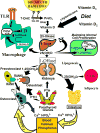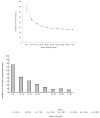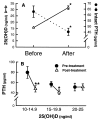Vitamin D status: measurement, interpretation, and clinical application - PubMed (original) (raw)
Review
Vitamin D status: measurement, interpretation, and clinical application
Michael F Holick. Ann Epidemiol. 2009 Feb.
Abstract
Vitamin D, the sunshine vitamin, is now recognized not only for its importance in promoting bone health in children and adults but also for other health benefits, including reducing the risk of chronic diseases such as autoimmune diseases, common cancer, and cardiovascular disease. Vitamin D made in the skin or ingested in the diet is biologically inert and requires 2 successive hydroxylations first in the liver on carbon 25 to form 25-hydroxyvitamin D [25(OH)D], and then in the kidney for a hydroxylation on carbon 1 to form the biologically active form of vitamin D, 1,25-dihydroxyvitamin D [1,25(OH)(2)D]. With the identification of 25(OH)D and 1,25(OH)(2)D, methods were developed to measure these metabolites in the circulation. Serum 25(OH)D is the barometer for vitamin D status. Serum 1,25(OH)(2)D provides no information about vitamin D status and is often normal or even increased as the result of secondary hyperparathyroidism associated with vitamin D deficiency. Most experts agree that 25(OH)D of <20 ng/mL is considered to be vitamin D deficiency, whereas a 25(OH)D of 21-29 ng/mL is considered to be insufficient. The goal should be to maintain both children and adults at a level >30 ng/mL to take full advantage of all the health benefits that vitamin D provides.
Figures
Figure 1
The metabolism and biologic function of vitamin D. During exposure to sunlight, 7-dihydrocholesterol (7-DHC) is photolyzed to previtamin D3 (preD3). Body heat converts preD3 to vitamin D3. Vitamin D2 and vitamin D3 in the diet and vitamin D made in the skin enters the circulation and either is stored in the body’s fat adipocytes or enters the liver and is converted to 25-hydroxyvitamin D [25(OH)D]. For regulation of calcium metabolism, 25(OH)D is converted in the kidneys to 1,25-dihydroxyvitamin D [1,25(OH)2D]. 1,25(OH)2D interacts with its vitamin D receptor (VDR) in the small intestine and on osteoblasts to regulate calcium and phosphorus metabolism. 25(OH)D is metabolized in various tissues and cells for regulating cellular proliferation and differentiation as well as inducing cathelicidin D(CD) in macrophages. The induction of 1,25(OH)2D in the macrophage is controlled by the 2/1 toll-like receptors (TLR) and its interaction with lipopolysaccharide (LPS). In addition, circulating concentrations of 1,25(OH)2D may help increase insulin production and decrease renin production and alter adipocyte lipogenesis. With permission; copyright Michael F. Holick.
FIG. 2
A, Mean (±SE) serum PTH (picograms per milliliter) by serum 25(OH)D subgroups. Subject PTH concentrations (picograms per milliliter) relative to serum 25(OH)D concentrations sorted by subgroups delineated by predefined cutoffs for analyses of 25(OH)D inadequacy. Serum PTH values began to increase with 25(OH)D concentrations less than 29.8 ng/ml. B, Percent of subjects with secondary hyperparathyroidism by 25(OH)D level. The percent of subjects with secondary hyperparathyroidism (PTH > 40 pg/ml) sorted by subgroups with serum 25(OH)D concentrations delineated by predefined cutoffs for analyses of 25(OH)D inadequacy. Reproduced with permission.
Figure 3
(A) Serum levels of 25(OH)D (-Δ-) and PTH (-o-) before and after therapy with 50,000 IU of vitamin D2 and calcium supplementation once a week for 8 weeks. (B) Serum levels of PTH levels in patients who had serum 25(OH)D levels of between 10 and 25 ng/ml and who were stratified in increments of 5 ng/ml before and after receiving 50,000 IU of vitamin D2 and calcium supplementation for 8 weeks. Reproduced with permission.
FIG. 4
Laboratory personnel basal serum 25(OH)D concentration. A, In these 10 individuals, the mean serum 25(OH)D varied widely [from 17.1 (4.6) to 35.6 (5.2) ng/ml; P < 0.005] between laboratories (error bars represent SEM). B, Similarly, marked within-individual variation was observed in 25(OH)D measurement in different laboratories. Whether an individual has hypovitaminosis D (arbitrary threshold, 32 ng/ml shown as dashed line) depends on which laboratory was used. Note that laboratory H used HPLC and was considered to be the “gold standard” against which others were compared. Reproduced with permission.
Similar articles
- VITAMIN D BINDING PROTEIN AND 25-HYDROXYVITAMIN D LEVELS: EMERGING CLINICAL APPLICATIONS.
Jassil NK, Sharma A, Bikle D, Wang X. Jassil NK, et al. Endocr Pract. 2017 May;23(5):605-613. doi: 10.4158/EP161604.RA. Epub 2017 Jan 17. Endocr Pract. 2017. PMID: 28095044 Free PMC article. Review. - Serum cholecalciferol may be a better marker of vitamin D status than 25-hydroxyvitamin D.
Jorde R, Grimnes G. Jorde R, et al. Med Hypotheses. 2018 Feb;111:61-65. doi: 10.1016/j.mehy.2017.12.017. Epub 2017 Dec 13. Med Hypotheses. 2018. PMID: 29406999 - Assessment criteria for vitamin D deficiency/insufficiency in Japan - proposal by an expert panel supported by Research Program of Intractable Diseases, Ministry of Health, Labour and Welfare, Japan, The Japanese Society for Bone and Mineral Research and The Japan Endocrine Society [Opinion].
Okazaki R, Ozono K, Fukumoto S, Inoue D, Yamauchi M, Minagawa M, Michigami T, Takeuchi Y, Matsumoto T, Sugimoto T. Okazaki R, et al. Endocr J. 2017 Jan 30;64(1):1-6. doi: 10.1507/endocrj.EJ16-0548. Epub 2016 Dec 20. Endocr J. 2017. PMID: 28003569 - Vitamin D status and its relationship with bone mineral density in healthy Asian Indians.
Arya V, Bhambri R, Godbole MM, Mithal A. Arya V, et al. Osteoporos Int. 2004 Jan;15(1):56-61. doi: 10.1007/s00198-003-1491-3. Epub 2003 Sep 12. Osteoporos Int. 2004. PMID: 13680103 - Why should we measure free 25(OH) vitamin D?
Tsuprykov O, Chen X, Hocher CF, Skoblo R, Lianghong Yin, Hocher B. Tsuprykov O, et al. J Steroid Biochem Mol Biol. 2018 Jun;180:87-104. doi: 10.1016/j.jsbmb.2017.11.014. Epub 2017 Dec 5. J Steroid Biochem Mol Biol. 2018. PMID: 29217467 Review.
Cited by
- Assessing the relative importance of vitamin D deficiency in cardiovascular health.
Rubab M, Kelleher JD. Rubab M, et al. Front Cardiovasc Med. 2024 Oct 16;11:1435738. doi: 10.3389/fcvm.2024.1435738. eCollection 2024. Front Cardiovasc Med. 2024. PMID: 39479391 Free PMC article. - Accelerated bone loss in late reproductive-aged and perimenopausal women with vitamin D insufficiency.
Kim MJ, Kim S, Kim JJ, Han KH. Kim MJ, et al. J Bone Miner Metab. 2024 Sep 30. doi: 10.1007/s00774-024-01556-w. Online ahead of print. J Bone Miner Metab. 2024. PMID: 39349871 - Vitamin D content and prevalence of vitamin D deficiency in patients with epilepsy: a systematic review and meta-analysis.
Liu Y, Gong C, Li J, Ning X, Zeng P, Wang L, Lian B, Liu J, Fang L, Guo J. Liu Y, et al. Front Nutr. 2024 Aug 30;11:1439279. doi: 10.3389/fnut.2024.1439279. eCollection 2024. Front Nutr. 2024. PMID: 39279896 Free PMC article. - Establishment of Reference Intervals for Bone Turnover Biomarkers in Healthy Populations in Northern China.
Huo L, Liu X, Wei C, Yu F, Ren L, Tie Y. Huo L, et al. Int J Gen Med. 2024 Sep 7;17:3955-3965. doi: 10.2147/IJGM.S471403. eCollection 2024. Int J Gen Med. 2024. PMID: 39268179 Free PMC article. - Levels of free thyroxine are higher in displaced pediatric supracondylar humerus fractures compared with non‑displaced fractures.
Imazu N, Naito K, Kawakita S, Suzuki T, Yamamoto Y, Kawamura K, Ishijima M. Imazu N, et al. Exp Ther Med. 2024 Aug 20;28(4):404. doi: 10.3892/etm.2024.12693. eCollection 2024 Oct. Exp Ther Med. 2024. PMID: 39234584 Free PMC article.
References
- Huldschinsky K. Heilung von Rachitis durch Kunstliche Hohensonne. Deutsche Med Wochenschr. 1919;45:712–713.
- Hess AF, Unger LJ. The cure of infantile rickets by sunlight. JAMA. 1921;77:39–41.
- Holick MF. High prevalence of vitamin D inadequacy and implications for health. Mayo Clin Proc. 2006;81(3):353–373. - PubMed
- Belsey R, Clark MB, Bernat M, Glowacki J, Holick MF, DeLuca HF, et al. The physiologic significance of plasma transport of vitamin D and metabolites. Am J Med. 1974;57:50–56. - PubMed
Publication types
MeSH terms
Substances
Grants and funding
- M01RR00533/RR/NCRR NIH HHS/United States
- M01 RR000533/RR/NCRR NIH HHS/United States
- M01 RR000533-407263/RR/NCRR NIH HHS/United States
- R01 AR036963-12/AR/NIAMS NIH HHS/United States
- R01 AR036963/AR/NIAMS NIH HHS/United States
- AR36963/AR/NIAMS NIH HHS/United States
LinkOut - more resources
Full Text Sources
Other Literature Sources
Medical



